Russian stove with stove: technology for laying a Russian stove with diagrams and detailed orders
Despite the huge number of modern heating devices, stoves in the house do not lose their position.However, brick buildings of the 21st century differ in many ways from their predecessors - bulky classic Russian stoves with a large stove bench and very limited heat transfer.
One of the most effective solutions is the Russian stove with a stove - more compact and suitable for heating both a country house and a building for permanent residence. We suggest considering the diagrams and arrangements of the model with a slab, which you may need if you decide to start building it yourself.
The content of the article:
Stove with stove - multifunctional structure
The stove is so useful, convenient and ergonomic that building a structure without it simply loses its meaning. Perhaps this is why all modern modifications of Russian stoves have cast iron stoves - with one, two or even three burners.
In fact, models with a stove do not contradict one of the main features of a Russian stove - they have two fireboxes. It is the small firebox that is responsible for heating the stove. Moreover, in simple stoves it has a separate chimney, connected at the top to the chimney of the furnace.
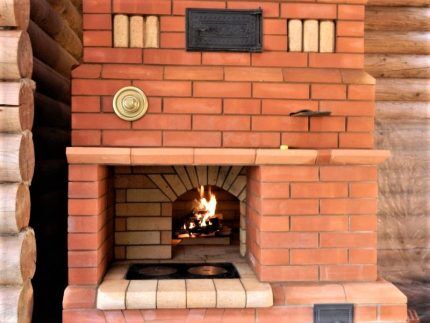
For more complex designs, there is the possibility of “summer” and “winter” fireboxes: in the first case, the small furnace (furnace) operates autonomously, and in the second, with its help, the walls and the large furnace are heated.
There is a third option for locating the flooding - in the main structure, but on the side or on the opposite side. This solution is not always acceptable - for example, if the stove needs to be located in a corner. In this case, it is more convenient if both fireboxes are on one side and located one above the other.
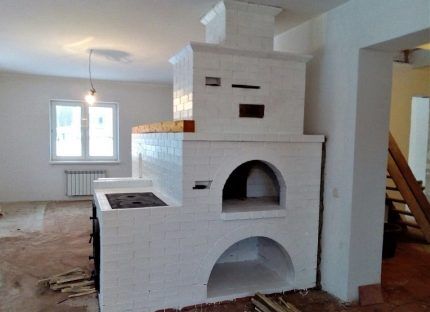
The advantages of the design with a hob are obvious:
- autonomous heating with a lower degree of heat transfer;
- fast heating process of cast iron and walls;
- cooking all kinds of dishes on the stove;
- the ability to heat or store food warm;
- economical fuel consumption - firewood;
- easy maintenance - cleaning the ash pan.
On the stove, when it is no longer hot, but has cooled down a little, you can dry household items. For the same purpose, stoves are used - small recesses in the walls of the stove, as well as a brick perimeter around the cast-iron surface.
For summer residents, the model with flooding is much more convenient, as it is used more often. A large firebox is usually used either in early spring or late autumn, when the cold season sets in and the entire stove needs to be heated.
Popular order options
Having in your hands the order of a Russian stove with a hob, you can lay out the structure with your own hands. Of course, you will need the help of an experienced craftsman, since everything is important in masonry: from the proportions of the components in the mortar to the choice of building and insulating materials.
We offer two options that are most often demanded by owners of private houses.
Option #1 – with a stove and a stove bench
One of the most favorite solutions that combines all the advantages of a real Russian oven: a large furnace for baking bread, a convenient stove for cooking and a wide bed, which can be used as an additional sleeping place on cold winter nights.

Construction begins, as is customary, with the construction of the foundation. We remind you that it is not connected to the foundation of the house and is constructed separately. To do this, they usually dig a hole, make formwork and use reinforcement to fill it with cement mortar.
After it has matured, the base is insulated with basalt cardboard, steel or other material, leveled and the construction of the stove masonry begins.
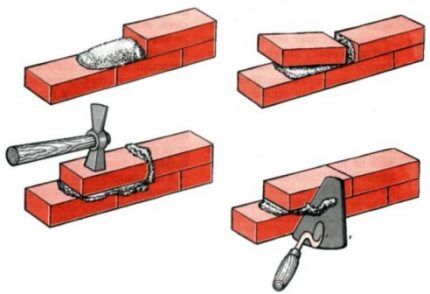
Tools: trowel, level, square, plumb line, rule - it is better to prepare in advance so that everything is at hand. You also need to buy all the necessary materials: a cast iron 2-burner stove, combustion and cleaning doors, a grate, valves, a view.
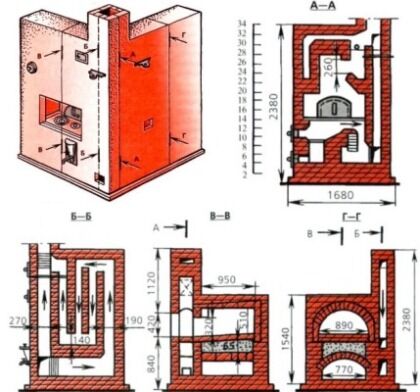
The stove model with a stove bench and tiles has one feature - the stove bench is surrounded by walls on both sides. This can be clearly seen in the order presented below.
Arranging a stove with a stove bench and stove

When installing a cast iron stove, you need to take into account the expansion of the metal when heated.
To do this, gaps of 2-3 mm are left on the sides, and the slab itself is not placed on the mortar, but left to lie loose so that it can be easily removed if necessary.
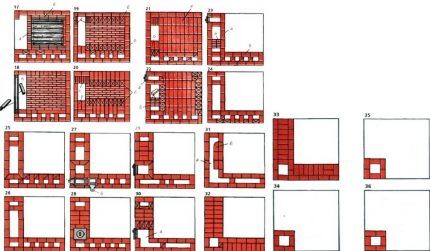
If it seems to you that the construction of the final element - the chimney - is the easiest, then you are mistaken.
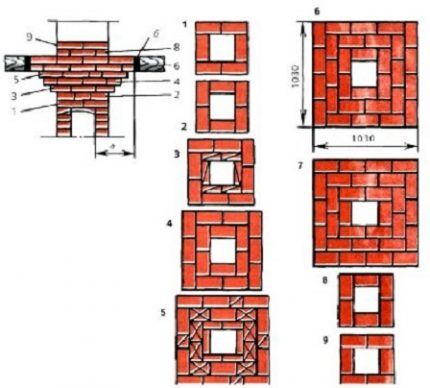
Experienced stove makers, when laying a chimney, carefully select the bricks: they take the smoothest ones and place them with the smoothest side inward. This is necessary to reduce the degree of contamination of the internal surface - less soot settles on smooth walls, so they have to be cleaned less often.
Option #2 – with a stove under the cauldron
Despite the fact that the presented sample has almost all the elements of a traditional Russian stove, it takes up little space, is very convenient and functional.
The stove is large in size, it is easy to place not only pots on it, but also a large cauldron for preparing oriental dishes.

When using both fireboxes, you can heat a house with an area of up to 40-50 m², but if the structure is intended for a country house, then a small firebox stove with a stove will be more actively used.
Arrangement of the stove and stove
Changes can be made to the order, but on the condition that they do not contradict safety, logic and masonry rules.
In the 7th row, instead of a simple ceiling, you can build an arch, but only an experienced stove maker can do this, since building an arch requires additional time and knowledge of special techniques for processing and laying bricks.
At this stage, the masonry becomes quite high, so there is often a need for special scaffolding.
An ordinary stool is not enough, since in addition to the stove-maker, it is necessary to place a container with mortar and bricks at a certain height.
In the future, you can also use fireclay bricks, but solely for aesthetic purposes. The characteristics do not matter; if desired, you can make the masonry as before - with red solid brick.
Next, only the pipe is erected - to the distance remaining to the ceiling.
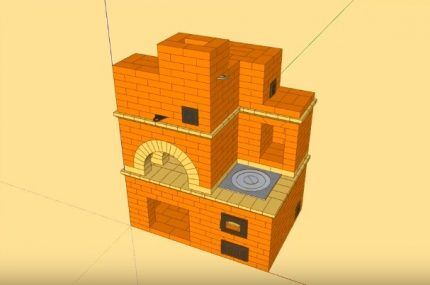
The presented arrangement is suitable for those who do not need a large bed. Otherwise, you will have to increase the length of the combustion chamber or build an extension with smoke ducts inside.
Recommendations from experienced stove makers
If you have an order and a stack of drawings in your hands, this does not mean that all the secrets of professional masonry are open to you. There are many little things that need to be taken into account when building a Russian stove.
To make your work easier and the results of your work justified, pay attention to simple but effective rules:
Do not forget about the quality of the main materials - bricks and mortar, on which both the heating efficiency and the service life of the structure as a whole depend.
Conclusions and useful video on the topic
Ordering a stove with a large stove bench and tiles:
The procedure for constructing a furnace with flooding:
Outdoor barbecue option with stove:
There are a great many options for constructing an oven with a hob - stove. However, we do not recommend starting to build any chosen model on your own without practice. Be sure to study the topical information and enlist the support of a qualified craftsman, whose results of work you are familiar with first-hand.
Please write comments in the block form located under the text of the article. Tell us how you built a stove and cooking stove in your country house or at your favorite dacha. Ask questions on the topic, post photographs of the process of construction or operation of a brick unit.




I've heard about the low efficiency of such a Russian stove. Does this correspond to reality or is it not the stove diagram that is to blame, but the hands of the stove maker? I would like to see a comparison with the “Dutch” and the “Swedish”.
The low efficiency of the Russian traditional stove is an old tale. There are a great variety of types of masonry for such stoves, and accordingly, the efficiency varies greatly depending on the design and skill of the stove maker.
If we take the average efficiency value, then for a Russian stove it is about 20-25%. The Dutch woman has the same indicator. The Swedish has, of course, higher efficiency - about 35-40%.
Efficiency is generally an abstract concept) And when considering different types of stoves, it is worth taking into account not only the temperature regime, but also wear and tear during operation, the peculiarities of the choice of fuel and its quantity, the heated area, the location of the device, and so on. And why are you comparing completely different types of stoves - heating and heating-cooking?
In the comment above, the efficiency of a Russian stove is indicated at 20-25%. Well, if we talk about efficiency, such indicators are given by a fireplace with an open firebox, and a Russian stove is characterized by indicators of at least 60% (in the simplest version). A normal master, with experience, a simple Russian stove maker, coming to your home, will not talk about any efficiency at all. He will say - you need a heating stove. Depending on the size of the room and the location of the device, this model will suit you. It will warm up your room to so many degrees and will consume so much wood/coal per day.
Or a heating and cooking stove, or a fireplace stove... Provided that “I will build it, with the materials I purchased.”